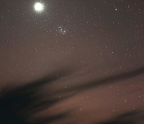
EVERY WEEK OR TWO, somewhere in our vast galaxy, an Earth-size star erupts in a nuclear blast. The tiny star’s outer layers explode, unleashing a flash of light we might see as a ‘new star,’ or nova, that shines with the visual luminosity of some 100,000 Suns.
Yet the much rarer supernovae get all the press. “Nobody cares about novae, and this is a mistake,” says Francesca Matteucci (University of Trieste, Italy), who studies how stars enrich the cosmos with chemical elements. “I’m convinced that novae are very important” for the creation of new elements, she says.
Predictions of nova nucleosynthesis go back nearly half a century. In the 1970s, scientists calculated that novae could mint notable amounts of lithium, a scarce element that’s now critical for modern technology. The theory later ran into trouble, but new observations have dramatically revived it.
Still, astronomers don’t know how often novae occur and therefore can’t quantify how much these explosions contribute to the Milky Way’s supply of chemical elements. Plus, novae no longer light up the skies the way they once did. First-magnitude novae used to appear every decade, but it’s been 81 years since the last one, and at least one astronomer thinks it’s your fault.
An explosive situation
At one time, astronomers thought any star could go nova — even our own Sun. In his 1940 book The Birth and Death of the Sun, George Gamow wrote (emphasis in original): “We must admit, to start with, that the a priori chances of our Sun’s becoming an ordinary nova once during its




